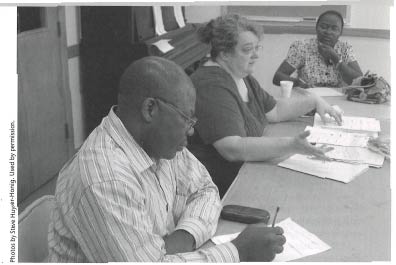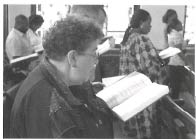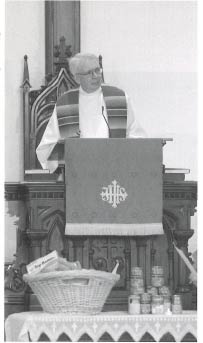Updated June, 2025
The sermon ends and the organist launches into the “sermon hymn.” In many congregations this is where the service begins winding down. But at Eliot Presbyterian Church in Lowell, Massachusetts, the sermon hymn signals a worship practice that people look forward to all week.
As the congregation sings, several people move forward to sit in the front pew. Others join them. Two by two, they talk quietly and then pray together—with eyes open or closed, heads bowed or not, hands folded or clasped.
Eliot Presbyterian’s tradition of requesting and offering personal prayer during worship reveals the value its members place on faith formation, learning about worship, and trusting the Holy Spirit.
Faith Formation in Worship
The sermon hymn always has at least four verses. “If there are more people than can be prayed for during the hymn, the congregation continues in prayer and the organist continues playing. Time seems to stand still,” says Lolly Wigall, chair of Christian education.
The wife of a previous pastor started the front-pew prayers more than seven years ago. “Members began to request personal prayers on specific issues like loss of jobs, death in the family, sickness, and joining the army,” says Osei Bonsu, who drums and sings in Eliot’s African Fellowship Choir.
When Edward C. “Ted” Zaragoza left seminary teaching to become Eliot’s pastor in 2004, he knew how much those prayers mattered. He says, “The service . . . had no sense of worship as a dialogue. I added headings in the bulletin to help people learn how to think about worship: ‘Called by God, We Gather’; ‘Spoken to by God, We Listen’; ‘Blessed by God, We Give Thanks’; ‘Sent by God, We Go Out.’

Zaragoza offers small doses of teaching week by week. The order of service tells worshipers where they are in liturgical time, for example, “Twenty-fifth Sunday in Ordinary Time.” This is followed by a little teaching sentence such as “The Greek word ‘eucharista’ means ‘thanksgiving.’”
Zaragoza has also preached a sermon series based on ten core convictions of Christian worship. Above all, though, he models what it means to be part of a community that is relational, trusting, and honest. “This reshaping of our membership leads to a willingness to chip in, not simply to ‘be led,’” says Scottie Farber, a worship committee member.
Faith Formation in Congregational Life
“Liturgy—the structure, flow, and movement of worship—and the sacraments all matter to me as models for living life. I don’t act unilaterally, because collaborative, collegial learning among cultures is very gradual,” Zaragoza says.
Some people used to ask others why they went up to request prayer. “Ted taught us that we shouldn’t ask, because the prayers are confidential,” several report.
Last year some Cambodian parents in the church, most of whom grew up Buddhist, confided that they didn’t know how to pray. The worship committee planned an intergenerational event. All ages turned out for the Saturday workshop on blessing through prayer. Later, parents and Sunday school teachers received training on how to help children learn to pray.
“A common goal here is for everyone to learn how to pray and write a statement of faith. Now, in our extended family, the kids say the prayers. They like it enough to become part of our adult activities,” says Emmy Kisob, an elder who grew up Presbyterian in Cameroon.
Monthly worship committee meetings follow the four-fold worship pattern of gathering, learning, eating, sending. Members gather around a meal. They review past services, help plan future ones and always learn together—whether from a video on global worship, a book, or a story from the Calvin Institute of Christian Worship.
“We’ve been learning that the prayers, hymns, and sermon should all relate to the Scripture. Everything needs to flow together, so no more ‘Yahoo Jesus!’ music in Lent,” says Greg Edlund, a church musician and worship committee chair.

Learning by Leading
Eliot used to do its front-pew prayers at the end of the service. But since personal prayers are more often about concerns than joys, the congregation decided to put them after the sermon and before the part of the service called “Blessed by God, We Give Thanks.” Now worship ends on an upswing.
Originally elders or pastors prayed for people. Zaragoza says that made people think that only a special group could pray. “About a year ago, we started saying, ‘Come forward and a member of the congregation will pray with you.’”
He gave two brief trainings and handed out tiny green “cheat sheets” on how to pray with people. “Pray for what they ask for, not what you think they need,” he advised.

Recently Zaragoza began assigning elders and deacons to serve as lay liturgists. Before they lead, he has them practice by standing at the pulpit and getting used to looking out at the pews. Liturgists are in charge from the call to worship through two songs, the confession of sin and assurance of forgiveness, passing the peace, and the prayer for illumination and Old Testament or epistle readings.
Eventually he hopes that members will also do the congregational prayer, composed mainly from the requests and praises on prayer slips that worshipers put in offering plates.
Elder Sothara Ly says, “Especially for my people (Cambodians), it is not comfortable to stand in front of a group. Before, I didn’t see the need for anyone besides the pastor to help with the liturgy. Now I am grateful to help lead. Watching someone else be the lay liturgist helps us learn from and know each other better.”

Trusting the Holy Spirit’s Leading
Worship at Eliot Presbyterian has changed since octogenarian Evie McCartney was a girl. “Pastor Ted has encouraged more participation in worship, and this has brought out new talents never before seen,” says McCartney, an elder and worship committee member.
Long-time members say Eliot has always been anchored by Scripture and Presbyterian polity. But the congregation has become more flexible since the early 1980s, when a former pastor began sponsoring Cambodian refugees. The church also began drawing Africans in the 1990s.
The flexibility born from welcoming new cultures has opened Eliot in other ways. “Any number of people go forward to pray with those who need prayer. No one is assigned. They just go up as the Spirit moves,” Lolly Wigall notes.
Gordon Halm, who grew up Anglican in Ghana, says that participating in the prayer time is all about faith. “When a call of this nature is made, it can be very hard. Here people get off their seat. I find that very special.”
Zaragoza at times interrupts the “normal” flow of worship for a special prayer. People who are seriously ill or who have been traumatized by immigration roundups are often anointed with oil or receive the laying on of hands.
“I remind people that we are not in control of the service—the Holy Spirit is,” he says.

